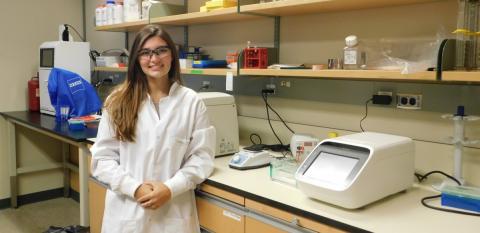Graduate Student Feature: Tracking Emerging Contaminants in NH

UNH graduate student Cassidy Yates is helping to study the way we track and manage new contaminants in New Hampshire waters. A growing concern around the world and here in New Hampshire is the build-up of human-made chemical contaminants in our environment. Leading the pack in a category called Contaminants of Emerging Concern are per- and polyfluoroalkyl substances (PFAS).
“There's around five thousand of these compounds [PFAS], and they're found in industrial, commercial and household products, from raincoats to nonstick cookware – things that we're using in our everyday life,” said University of New Hampshire (UNH) graduate student Cassidy Yates.
Yates is a first-year master’s student in Environmental Engineering, working with Dr. Paula Mouser and Dr. Jim Malley, whose New Hampshire Sea Grant-funded research project seeks to understand how wastewater treatment affects the levels of PFAS and other Contaminants of Emerging Concern in our local environment.
“We're finding that these chemicals and substances are showing up in the environment, and then cycling through the environment through different waste streams like landfills and wastewater treatment facilities,” said Yates. PFAS are a relatively recent concern in the field, recent enough that they weren’t a focus in her undergraduate curriculum in Environmental Engineering at UNH, which she finished this past spring 2020.
Yates first learned about PFAS in earnest on her own. “I actually went to my first conference with the American Water Works Association last summer, and I sat in on a couple sessions and I really learned about these for the first time,” she said. The experience led her to dig deeper into PFAS in New Hampshire groundwater for her senior design project.
In her senior design project, Yates used data from the New Hampshire Department of Environmental Services and statistical analyses to determine the range of concentrations and types of PFAS present in New Hampshire groundwater, including which PFAS may be found together based on the length of the molecule, which plays a role in how easily a given PFAS molecule breaks down.
This summer, Yates and another UNH master’s student Sydney Adams have continued working on PFAS topics with Dr. Mouser and Dr. Malley, analyzing data collected by past master’s students from sludge from wastewater treatment facilities. Sludge represents the solid fraction that is collected, separated, and removed from water during the treatment process. Once stabilized, sludge becomes a valuable biosolid containing key macronutrients and can be used for fertilizer, so it can travel far beyond its hometown wastewater treatment plant.
“[Sludge] is collected in one place at the facility, then is sent elsewhere to be processed into biosolids, and then transported elsewhere again to be beneficially used in applications such as farms,” Yates explained. To augment their study of New Hampshire sludge, the team has also sourced data from Vermont, as some of New Hampshire's biosolids are applied throughout New England.
"There's around five thousand of these compounds [PFAS], and they're found in industrial, commercial and household products, from raincoats to nonstick cookware – things that we're using in our everyday life."
- CASSIDY YATES, UNH GRADUATE STUDENT
Yates and Adams have found that PFAS in biosolids is an understudied topic. “Sydney and I have been digging around and talking on Zoom to professionals and regulators, and we just can't find the information we're looking for. So, it's definitely good that we're working on this and calling out these research gaps,” Yates said.
Once lab and field work open back up, both of which were off-limits due restrictions associated with the COVID-19 pandemic, Yates expects she’ll transition to working more closely on Dr. Mouser and Dr. Malley’s Sea Grant-funded project and begin looking more closely at tracking and managing PFAS content in wastewater effluent and the environment. Dr. Mouser was awarded additional NH Sea Grant funding as part of the Graduate Fellowship in Coastal Resources program to enhance graduate student engagement on this project.
Removing PFAS and pharmaceuticals and personal care products (PPCPs) from wastewater is costly in its current form; PFAS are primarily removed from drinking water using granular activated carbon with some projects applying ion exchange resins or membrane filtration, but these treatment methods are not commonly used in wastewater.
“I'll start to look at chemical disinfection and other processes in the wastewater treatment plant that we have some data about like chlorination and de-chlorination, alone and in combination with UV light to treat the water before it's released into the receiving water body,” said Yates. “We also want to look into some other research gaps and how PFAS can be removed, because we're not seeing it removed very well in the current wastewater process.”
Wastewater treatment plants are major conduits of Contaminants of Emerging Concern like PFAS, so targeting strategies to reduce their presence before they’re released into estuaries like New Hampshire's Great Bay would help reduce the amount of PFAS that makes it into our local communities and environment.
After her master’s work, Yates is interested in applying what she’s learned to working with communities and industries. “I really like the social side of all the environmental problems that we see. So, getting out there and getting involved and doing my part to help communities, I think would be really great.”